There is broad interest in better understanding the importance of landscape linkages among what were once thought to be isolated ecosystems. Some of the most interesting questions relate to linkages between aquatic and terrestrial ecosystems, i.e. within aquatic systems such as littoral pelagic linkages, and among aquatic systems such as lakes and the coastal ocean. Mobile animals are particularly important in linking ecosystems because they can move material against naturally established gradients (e.g., upstream or upslope) and they directly link animal behavior and population dynamics to ecosystem dynamics of the recipient systems.
Wildebeest and Hippos in the Mara River basin (The Mara Project)
Amanda Subalusky, Christopher Dutton, and David Post are working with collaborator Emma Rosi-Marshall in the Mara River of East Africa to understand how 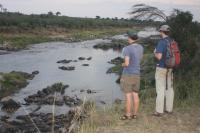 the form of animal resource subsidy interact with environmental characteristics to impact ecosystem function (The Mara Project). The Mara River passes through Kenya’s Masai Mara National Reserve and Tanzania’s Serengeti National Park before entering Lake Victoria. The Mara sustains the largest remaining overland migration in the world of 1.5 million wildebeest (Connochaetes taurinus) and a population of over 4,000 hippos (Hippopotamus amphibius). During the migration (July – November), wildebeest provide a major subsidy to the river in the form of carcasses through periodic mass drowning events of thousands of individuals. Hippos provide a constant
the form of animal resource subsidy interact with environmental characteristics to impact ecosystem function (The Mara Project). The Mara River passes through Kenya’s Masai Mara National Reserve and Tanzania’s Serengeti National Park before entering Lake Victoria. The Mara sustains the largest remaining overland migration in the world of 1.5 million wildebeest (Connochaetes taurinus) and a population of over 4,000 hippos (Hippopotamus amphibius). During the migration (July – November), wildebeest provide a major subsidy to the river in the form of carcasses through periodic mass drowning events of thousands of individuals. Hippos provide a constant 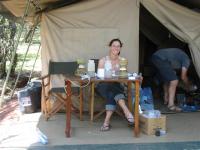 subsidy to the system in the form of nutrient elimination (egestion and excretion) from grass consumed in the surrounding terrestrial system and defecated into the river, transferring 9 tons/hippo/year of terrestrial biomass to the river. Our overarching hypothesis is that resource inputs by hippos and wildebeest differ in their effects on river ecosystem function and trophic structure, and that these inputs and their effects are mediated by discharge. Our research is supported by the National Science Foundation, the National Geographic Society, a Switzer Fellowship to Amanda Subalusky, and the Yale Institute of Biospheric Studies. For more information on this project, please see The Mara Project web site.
subsidy to the system in the form of nutrient elimination (egestion and excretion) from grass consumed in the surrounding terrestrial system and defecated into the river, transferring 9 tons/hippo/year of terrestrial biomass to the river. Our overarching hypothesis is that resource inputs by hippos and wildebeest differ in their effects on river ecosystem function and trophic structure, and that these inputs and their effects are mediated by discharge. Our research is supported by the National Science Foundation, the National Geographic Society, a Switzer Fellowship to Amanda Subalusky, and the Yale Institute of Biospheric Studies. For more information on this project, please see The Mara Project web site.
Related publications ( Post Lab publications ):
Subalusky, A.L., E.P. Anderson, G. Jiménez, D.M. Post, D. Echeverri Lopez, S. García, L.J. Nova León, J.F. Reátiga Parrish, A. Rojas, S. Solari, and L.F. Jiménez Segura. 2020. Potential ecological and socio-economic effects of a novel megaherbivore introduction: the hippopotamus in Colombia. Oryx. 55:105-113 doi:10.1017/S0030605318001588
Dutton, C.L, A.L. Subalusky, T.D. Hill, J.C. Aleman, E.J. Rosi, K.B. Onyango, K. Kanuni, J.A. Cousins, A.C. Staver, D.M. Post. 2019. A 2000-year sediment record reveals rapidly changing sedimentation and land use since the 1960s in the Upper Mara-Serengeti Ecosystem. Science of the Total Environment 664:148-160. doi:10.1016/j.scitotenv.2019.01.421
Schoelynck, J., A.L. Subalusky, E. Struyf, C.L. Dutton, D. Unzué-Belmonte, B. Van de Vijver, D.M. Post, E. J. Rosi, P. Meire, P. Frings. 2019. Hippos (Hippopotamus amphibius): the animal silica pump. Science Advances 5:eaav0395. doi:10.1126/sciadv.aav0395
Subalusky, A.L., and D.M. Post. 2019. Context dependency of animal resource subsidies. Biological Reviews 94:517-538. doi:10.1111/brv.12465
Dutton, C. L., A. L. Subalusky, S. K. Hamilton, E. J. Rosi, and D. M. Post. 2018. Organic matter loading by hippopotami causes subsidy overload resulting in downstream hypoxia and fish kills. Nature Communications 9:1951. doi:10.1038/s41467-018-04391-6
Dutton, C. L., A. L. Subalusky, S. C. Anisfeld, L. Njoroge, E. J. Rosi, and D. M. Post. 2018. The influence of an arid catchment and large wildlife on suspended sediments in the Mara River, Kenya. Plos One 13:e0192828. doi:10.1371/journal.pone.0192828
Subalusky, A.L., C.L. Dutton, E.J. Rosi, and D.M. Post. 2018. Organic matter and nutrient inputs from large wildlife influence ecosystem function in the Mara River, Africa. Ecology 99:2558-2574 doi:10.1002/ecy.2509
Subalusky, A.L., C.L. Dutton, E.J. Rosi-Marshall, and D.M. Post. 2017. Annual mass drownings of the Serengeti wildebeest migration influence nutrient cycling and storage in the Mara River. Proceedings of the National Academy of Sciences 114:7647-7652. doi:10.1073/pnas.1614778114
Subalusky, A.L. C.L. Dutton, E.J. Rosi-Marshall and D.M. Post. 2015. The hippopotamus conveyor belt: vectors of carbon and nutrients from terrestrial grasslands to aquatic systems in sub-Saharan Africa. Freshwater Biology 60:512-525. doi:10.1111/fwb.12474
Alewife
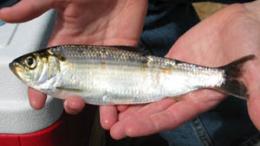 Members of the Post lab have explored the role of anadromous and landlocked alewife in coastal ecosystems in New England. Across New England, life history difference between landlocked and anadromous alewife mediate the spatial scale of interactions between alewife populations and local communities and ecosystems. Anadromous alewife populations create a spatial linkage between lakes where they spawn and the coastal ocean where they spend much of their life. In contrast, landlocked alewives provide no spatial linkage outside the lake in which they reside because dams or other similar impediments have severed their migratory route to the ocean.
Members of the Post lab have explored the role of anadromous and landlocked alewife in coastal ecosystems in New England. Across New England, life history difference between landlocked and anadromous alewife mediate the spatial scale of interactions between alewife populations and local communities and ecosystems. Anadromous alewife populations create a spatial linkage between lakes where they spawn and the coastal ocean where they spend much of their life. In contrast, landlocked alewives provide no spatial linkage outside the lake in which they reside because dams or other similar impediments have severed their migratory route to the ocean. 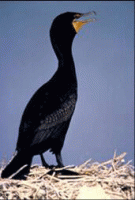 Because alewife are important as both predators and prey, they provide a system for simultaneous consideration of the effects of mobile predators and prey subsidies. Anadromous alewives are important vectors for moving marine-derived nutrients into freshwater ecosystems (Post and Walters 2009; Walters et al. 2009) and important prey for many coastal-breeding birds like cormorants (Dalton et al. 2009; Jones 2010) and osprey, and for fish predators in many coastal lakes. We have also explored how nutrient loading by anadromous alewife has changed historically (West et al. 2010, Twining et al. 2013), placing it into the context of human alterations of nutrient loading to coastal ecosystems (Twining et al. 2013). Because differences in spatial linkages emerge from variation in life history strategies, alewives also provide a model system for addressing a secondary question: how do intraspecific phenotypic differences (a result of life history evolution) influence population, community and ecosystem dynamics?
Because alewife are important as both predators and prey, they provide a system for simultaneous consideration of the effects of mobile predators and prey subsidies. Anadromous alewives are important vectors for moving marine-derived nutrients into freshwater ecosystems (Post and Walters 2009; Walters et al. 2009) and important prey for many coastal-breeding birds like cormorants (Dalton et al. 2009; Jones 2010) and osprey, and for fish predators in many coastal lakes. We have also explored how nutrient loading by anadromous alewife has changed historically (West et al. 2010, Twining et al. 2013), placing it into the context of human alterations of nutrient loading to coastal ecosystems (Twining et al. 2013). Because differences in spatial linkages emerge from variation in life history strategies, alewives also provide a model system for addressing a secondary question: how do intraspecific phenotypic differences (a result of life history evolution) influence population, community and ecosystem dynamics?
Related publications ( Post Lab publications ):
Twining, C.W., E.P. Palkovacs, M.A. Friedman, D.J. Hasselman, and D.M. Post. 2017. Nutrient loading by anadromous fishes: species-specific contributions and the effects of diversity. Canadian Journal of Fisheries and Aquatic Resources 74: 609–619 doi:10.1139/cjfas-2016-0136
Vanni, M.J., et al. 2017. A global database of nitrogen and phosphorus excretion rates of aquatic animals. Ecology 98:1475 doi:10.1002/ecy.1792
Twining, C.W., and D.M. Post. 2013. Cladoceran remains reveal presence of a keystone size-selective planktivore. Journal of Paleolimnology 49:253-266. doi:10.1007/s10933-012-9672-8
Twining, C.W., D.C. West, and D.M. Post. 2013. Historical changes in nutrient inputs from humans and anadromous fish in New England’s coastal watersheds. Limnology and Oceanography. 58:1286–1300. doi:10.4319/lo.2013.58.4.1286
Jones, A.W., C.M. Dalton, E.S. Stowe, and D.M. Post. 2010. Contribution of declining anadromous fishes to the reproductive investment of a common piscivorous seabird, the double-crested cormorant (Phalacrocorax auritus).Auk 127:696-703. doi:10.1525/auk.2010.09200
West, D.C., A.W. Walters, S. Gephard, and D.M. Post. 2010. Nutrient loading by anadromous alewives (Alosa pseudoharengus): contemporary patterns and predictions for restoration efforts. Canadian Journal of Fisheries and Aquatic Sciences 67:1211-1220. doi:10.1139/F10-059
Dalton, C.M., D. Ellis, and D.M. Post. 2009. The impact of double-crested cormorant (Phalacrocorax auritus) predation on anadromous alewife (Alosa pseudoharengus) in south-central Connecticut, USA. Canadian Journal of Fisheries and Aquatic Sciences 66(2): 177–186. doi:10.1139/F08-198
Post, D.M. and A.W. Walters. 2009. Nutrient excretion rates of anadromous alewives during their spawning migration. Transactions of the American Fishery Society 138(2): 264–268. doi:10.1577/T08-111.1
Walters, A.W., R.T. Barnes, and D.M. Post. 2009. Anadromous alewives (Alosa pseudoharengus) contribute marine-derived nutrients to coastal stream food webs. Canadian Journal of Fisheries and Aquatic Sciences 66(3): 439–448. doi:10.1139/F09-008
Migratory geese
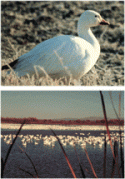 In collaboration with researchers at the University of Wisconsin - Madison and the US Fish & Wildlife, David Post has studied the role of migratory waterfowl in moving nutrients across the landscape of central New Mexico (Post et al. 1998, Kitchell et al. 1999). Birds are highly mobile vectors for nutrients. We found that over-wintering snow geese and sandhill cranes transport nutrients from farm fields, where they feed, to their roosting sites in managed wetlands at the Bosque del Apache National Wildlife Refuge. Nutrient inputs into these wetlands both augment nutrient availability and change nutrient cycling through modification of nitrogen-to-phosphorus ratios (bird excretion has low N:P).
In collaboration with researchers at the University of Wisconsin - Madison and the US Fish & Wildlife, David Post has studied the role of migratory waterfowl in moving nutrients across the landscape of central New Mexico (Post et al. 1998, Kitchell et al. 1999). Birds are highly mobile vectors for nutrients. We found that over-wintering snow geese and sandhill cranes transport nutrients from farm fields, where they feed, to their roosting sites in managed wetlands at the Bosque del Apache National Wildlife Refuge. Nutrient inputs into these wetlands both augment nutrient availability and change nutrient cycling through modification of nitrogen-to-phosphorus ratios (bird excretion has low N:P).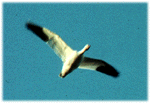 Although loading was extremely high in the few wetlands where the majority of geese roost (about half of the total annual nutrient load for those wetlands), the impacts were diluted at the larger spatial scale of the entire wetland complex where bird born nutrients had little effect on ambient nutrient concentrations. This project was especially germane in the Southwest where water quantity and quality, and the use of water by humans and wildlife, are in potential conflict. High nutrient inputs by birds exacerbate conservation and management problems associated with high bird densities and limited water supply.
Although loading was extremely high in the few wetlands where the majority of geese roost (about half of the total annual nutrient load for those wetlands), the impacts were diluted at the larger spatial scale of the entire wetland complex where bird born nutrients had little effect on ambient nutrient concentrations. This project was especially germane in the Southwest where water quantity and quality, and the use of water by humans and wildlife, are in potential conflict. High nutrient inputs by birds exacerbate conservation and management problems associated with high bird densities and limited water supply.
Related publications ( Post Lab publications ):
Kitchell, J.F., D.E. Schindler, B.R. Herwig, D.M. Post, M.H. Olson, and M. Oldham. 1999. Nutrient cycling at the landscape scale: the role of diel foraging migrations by geese at the Bosque del Apache National Wildlife Refuge, New Mexico. Limnology and Oceanography 44:828-836.
Post, D.M., J.P. Taylor, J.F. Kitchell, M.H. Olson, D.E. Schindler, and B.R. Herwig. 1998. The role of migratory waterfowl as nutrient vectors in managed wetlands. Conservation Biology 12:910-920.
Marine subsidies to islands
 Members of the Post Lab have also explored the role of subsidies between systems of similar productivity (Paetzold et al. 2008). Theoretical work suggest that the importance of allochthonous (subsidy) inputs depends upon the productivity gradient between adjacent systems. Much of the previous work on allochthonous (subsidy) inputs have focused on systems where there is a strong gradient in resource production (e.g., desert islands, cobble bars along productive islands). There exists very little empirical evidence for the importance of allochthonous inputs in systems where productivity of the recipient habitat is relatively high and not overwhelmed by the productivity of the donor habitat. We have tested these ideas on Horse Island, in Long Island Sound.
Members of the Post Lab have also explored the role of subsidies between systems of similar productivity (Paetzold et al. 2008). Theoretical work suggest that the importance of allochthonous (subsidy) inputs depends upon the productivity gradient between adjacent systems. Much of the previous work on allochthonous (subsidy) inputs have focused on systems where there is a strong gradient in resource production (e.g., desert islands, cobble bars along productive islands). There exists very little empirical evidence for the importance of allochthonous inputs in systems where productivity of the recipient habitat is relatively high and not overwhelmed by the productivity of the donor habitat. We have tested these ideas on Horse Island, in Long Island Sound. 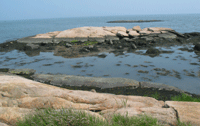 The forest of Horse Island is more productive then the relatively productive waters of Long Island Sound which surround the island. We used pitfall traps and stable isotope techniques to address the questions a) to what degree do major guilds of terrestrial arthropods derive energy from marine inputs, b) how far do marine resources penetrate the island, and c) are arthropod consumers are more abundant near shore or in inland areas? Our results provide the first estimates of the importance of marine resources to a terrestrial system where net primary production in the recipient habitat is similar to that of the donor habitat (Paetzold et al. 2008).
The forest of Horse Island is more productive then the relatively productive waters of Long Island Sound which surround the island. We used pitfall traps and stable isotope techniques to address the questions a) to what degree do major guilds of terrestrial arthropods derive energy from marine inputs, b) how far do marine resources penetrate the island, and c) are arthropod consumers are more abundant near shore or in inland areas? Our results provide the first estimates of the importance of marine resources to a terrestrial system where net primary production in the recipient habitat is similar to that of the donor habitat (Paetzold et al. 2008).
Related publications ( Post Lab publications):
Paetzold, A., M. Lee, and D.M. Post. 2008. Marine resource flows to terrestrial arthropod predators on a temperate island - the role of subsidies between systems of similar productivity. Oecologia 157:653-659.
Theory
David Post has also worked to understand how food web dynamics may be influenced by the movement of predators or the flow of energy and nutrients across ecosystem and sub-ecosystem boundaries. Using theoretical models, David has addressed how food web linkages created by mobile top predators may influence dynamical properties of food webs (Post et al. 2000). David has also addressed the problem of defining the boundaries of an ecosystem, an issue central to many questions in community and ecosystem ecology (Post et al. 2007).
Related publications ( Post Lab publications ):
Post, D.M., M.W. Doyle, J.L. Sabo, and J.C. Finlay. 2007. The problem of boundaries in defining ecosystems: a potential landmine for uniting geomorphology and ecology. Geomorphology 89:111-126.
Post, D.M., M.E. Conners, and D.S. Goldberg. 2000. Prey preference by a top predator and the stability of linked food chains. Ecology 81:8-14.